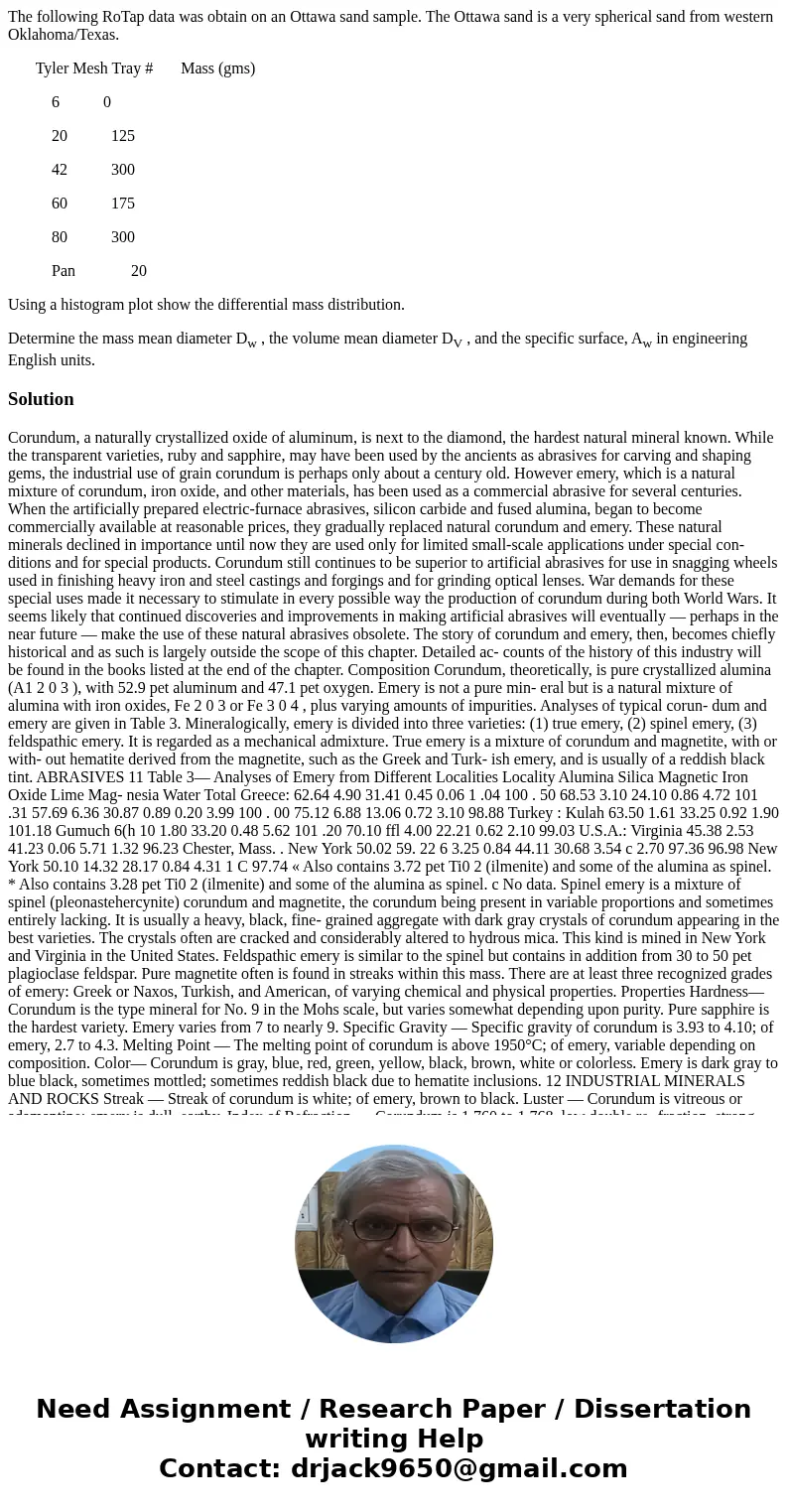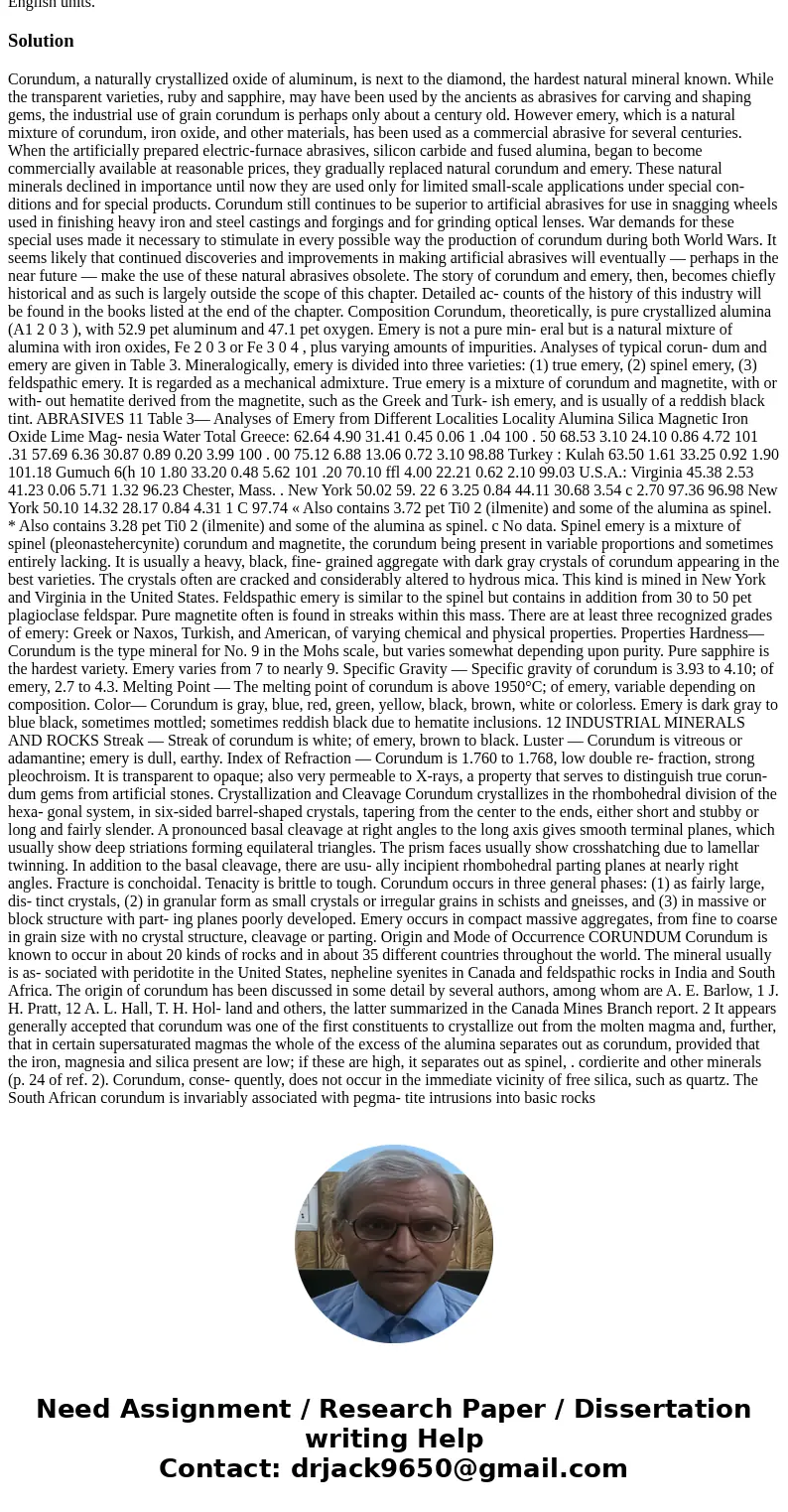The following RoTap data was obtain on an Ottawa sand sample
The following RoTap data was obtain on an Ottawa sand sample. The Ottawa sand is a very spherical sand from western Oklahoma/Texas.
Tyler Mesh Tray # Mass (gms)
6 0
20 125
42 300
60 175
80 300
Pan 20
Using a histogram plot show the differential mass distribution.
Determine the mass mean diameter Dw , the volume mean diameter DV , and the specific surface, Aw in engineering English units.
Solution
Corundum, a naturally crystallized oxide of aluminum, is next to the diamond, the hardest natural mineral known. While the transparent varieties, ruby and sapphire, may have been used by the ancients as abrasives for carving and shaping gems, the industrial use of grain corundum is perhaps only about a century old. However emery, which is a natural mixture of corundum, iron oxide, and other materials, has been used as a commercial abrasive for several centuries. When the artificially prepared electric-furnace abrasives, silicon carbide and fused alumina, began to become commercially available at reasonable prices, they gradually replaced natural corundum and emery. These natural minerals declined in importance until now they are used only for limited small-scale applications under special con- ditions and for special products. Corundum still continues to be superior to artificial abrasives for use in snagging wheels used in finishing heavy iron and steel castings and forgings and for grinding optical lenses. War demands for these special uses made it necessary to stimulate in every possible way the production of corundum during both World Wars. It seems likely that continued discoveries and improvements in making artificial abrasives will eventually — perhaps in the near future — make the use of these natural abrasives obsolete. The story of corundum and emery, then, becomes chiefly historical and as such is largely outside the scope of this chapter. Detailed ac- counts of the history of this industry will be found in the books listed at the end of the chapter. Composition Corundum, theoretically, is pure crystallized alumina (A1 2 0 3 ), with 52.9 pet aluminum and 47.1 pet oxygen. Emery is not a pure min- eral but is a natural mixture of alumina with iron oxides, Fe 2 0 3 or Fe 3 0 4 , plus varying amounts of impurities. Analyses of typical corun- dum and emery are given in Table 3. Mineralogically, emery is divided into three varieties: (1) true emery, (2) spinel emery, (3) feldspathic emery. It is regarded as a mechanical admixture. True emery is a mixture of corundum and magnetite, with or with- out hematite derived from the magnetite, such as the Greek and Turk- ish emery, and is usually of a reddish black tint. ABRASIVES 11 Table 3— Analyses of Emery from Different Localities Locality Alumina Silica Magnetic Iron Oxide Lime Mag- nesia Water Total Greece: 62.64 4.90 31.41 0.45 0.06 1 .04 100 . 50 68.53 3.10 24.10 0.86 4.72 101 .31 57.69 6.36 30.87 0.89 0.20 3.99 100 . 00 75.12 6.88 13.06 0.72 3.10 98.88 Turkey : Kulah 63.50 1.61 33.25 0.92 1.90 101.18 Gumuch 6(h 10 1.80 33.20 0.48 5.62 101 .20 70.10 ffl 4.00 22.21 0.62 2.10 99.03 U.S.A.: Virginia 45.38 2.53 41.23 0.06 5.71 1.32 96.23 Chester, Mass. . New York 50.02 59. 22 6 3.25 0.84 44.11 30.68 3.54 c 2.70 97.36 96.98 New York 50.10 14.32 28.17 0.84 4.31 1 C 97.74 « Also contains 3.72 pet Ti0 2 (ilmenite) and some of the alumina as spinel. * Also contains 3.28 pet Ti0 2 (ilmenite) and some of the alumina as spinel. c No data. Spinel emery is a mixture of spinel (pleonastehercynite) corundum and magnetite, the corundum being present in variable proportions and sometimes entirely lacking. It is usually a heavy, black, fine- grained aggregate with dark gray crystals of corundum appearing in the best varieties. The crystals often are cracked and considerably altered to hydrous mica. This kind is mined in New York and Virginia in the United States. Feldspathic emery is similar to the spinel but contains in addition from 30 to 50 pet plagioclase feldspar. Pure magnetite often is found in streaks within this mass. There are at least three recognized grades of emery: Greek or Naxos, Turkish, and American, of varying chemical and physical properties. Properties Hardness— Corundum is the type mineral for No. 9 in the Mohs scale, but varies somewhat depending upon purity. Pure sapphire is the hardest variety. Emery varies from 7 to nearly 9. Specific Gravity — Specific gravity of corundum is 3.93 to 4.10; of emery, 2.7 to 4.3. Melting Point — The melting point of corundum is above 1950°C; of emery, variable depending on composition. Color— Corundum is gray, blue, red, green, yellow, black, brown, white or colorless. Emery is dark gray to blue black, sometimes mottled; sometimes reddish black due to hematite inclusions. 12 INDUSTRIAL MINERALS AND ROCKS Streak — Streak of corundum is white; of emery, brown to black. Luster — Corundum is vitreous or adamantine; emery is dull, earthy. Index of Refraction — Corundum is 1.760 to 1.768, low double re- fraction, strong pleochroism. It is transparent to opaque; also very permeable to X-rays, a property that serves to distinguish true corun- dum gems from artificial stones. Crystallization and Cleavage Corundum crystallizes in the rhombohedral division of the hexa- gonal system, in six-sided barrel-shaped crystals, tapering from the center to the ends, either short and stubby or long and fairly slender. A pronounced basal cleavage at right angles to the long axis gives smooth terminal planes, which usually show deep striations forming equilateral triangles. The prism faces usually show crosshatching due to lamellar twinning. In addition to the basal cleavage, there are usu- ally incipient rhombohedral parting planes at nearly right angles. Fracture is conchoidal. Tenacity is brittle to tough. Corundum occurs in three general phases: (1) as fairly large, dis- tinct crystals, (2) in granular form as small crystals or irregular grains in schists and gneisses, and (3) in massive or block structure with part- ing planes poorly developed. Emery occurs in compact massive aggregates, from fine to coarse in grain size with no crystal structure, cleavage or parting. Origin and Mode of Occurrence CORUNDUM Corundum is known to occur in about 20 kinds of rocks and in about 35 different countries throughout the world. The mineral usually is as- sociated with peridotite in the United States, nepheline syenites in Canada and feldspathic rocks in India and South Africa. The origin of corundum has been discussed in some detail by several authors, among whom are A. E. Barlow, 1 J. H. Pratt, 12 A. L. Hall, T. H. Hol- land and others, the latter summarized in the Canada Mines Branch report. 2 It appears generally accepted that corundum was one of the first constituents to crystallize out from the molten magma and, further, that in certain supersaturated magmas the whole of the excess of the alumina separates out as corundum, provided that the iron, magnesia and silica present are low; if these are high, it separates out as spinel, . cordierite and other minerals (p. 24 of ref. 2). Corundum, conse- quently, does not occur in the immediate vicinity of free silica, such as quartz. The South African corundum is invariably associated with pegma- tite intrusions into basic rocks

 Homework Sourse
Homework Sourse